Chapter 14: Mendel and the Gene Idea
1/85
There's no tags or description
Looks like no tags are added yet.
Name | Mastery | Learn | Test | Matching | Spaced |
|---|
No study sessions yet.
86 Terms
Pea plants were particularly well suited for use in Mendel's breeding experiments for all of the following reasons except that
A) peas show easily observed variations in a number of characters, such as pea shape and flower color.
B) it is possible to completely control matings between different pea plants.
C) it is possible to obtain large numbers of progeny from any given cross.
D) peas have an unusually long generation time.
E) many of the observable characters that vary in pea plants are controlled by single genes.
D
A plant with purple flowers is allowed to self-pollinate. Generation after generation, it produces purple flowers. This is an example of
A) hybridization.
B) incomplete dominance.
C) true-breeding.
D) the law of segregation.
E) polygenetics.
C
Which of the following statements about Mendel's breeding experiments is correct?
A) None of the parental (P) plants were true-breeding.
B) All of the F2 progeny showed a phenotype that was intermediate between the two parental (P) phenotypes.
C) Half of the Fy progeny had the same phenotype as one of the parental (P)
plants, and the other half had the same phenotype as the other parent.
D) All of the Fy progeny resembled one of the parental (P) plants, but only some of the F2 progeny did.
E) none of the above
D
What is the difference between a monohybrid cross and a dihybrid cross?
A) A monohybrid cross involves a single parent, whereas a dihybrid cross involves two parents.
B) A monohybrid cross produces a single progeny, whereas a dihybrid cross produces two progeny.
C) A monohybrid cross involves organisms that are heterozygous for a single character, whereas a dihybrid cross involves organisms that are heterozygous for two characters.
D) A monohybrid cross is performed only once, whereas a dihybrid cross is performed twice.
E) A monohybrid cross results in a 9:3:3:1 ratio whereas a dihybrid cross gives a 3:1 ratio.
C
A cross between homozygous purple-flowered and homozygous white-flowered pea plants results in offspring with purple flowers. This demonstrates
A) the blending model of genetics.
B) true-breeding.
C) dominance.
D) a dihybrid cross.
E) the mistakes made by Mendel.
C
The F1 offspring of Mendel's classic pea cross always looked like one of the two parental varieties because
A) one allele was completely dominant over another.
B) each allele affected phenotypic expression.
C) the traits blended together during fertilization.
D) no genes interacted to produce the parental phenotype.
E) different genes interacted to produce the parental phenotype.
A
What was the most significant conclusion that Gregor Mendel drew from his experiments with pea plants?
A) There is considerable genetic variation in garden peas.
B) Traits are inherited in discrete units, and are not the results of "blending."
C) Recessive genes occur more frequently in the F1 than do dominant ones.
D) Genes are composed of DNA.
E) An organism that is homozygous for many recessive traits is at a disadvantage.
B
Which of the following is (are) true for alleles?
A) They can be identical or different for any given gene in a somatic cell.
B) They can be dominant or recessive.
C) They can represent alternative forms of a gene.
D) Only A and B are correct.
E) A, B, and C are correct.
E
What is genetic cross between an individual showing a dominant phenotype (but of unknown genotype) and a homozygous recessive individual called?
A) a self-cross
B) a testcross
C) a hybrid cross
D) an F1 cross
E) a dihybrid cross
B
How many unique gametes could be produced through independent assortment by an individual with the genotype AaBbCCDdEE?
A) 4
B) 8
C) 16
D) 32
E) 64
B
Two plants are crossed, resulting in offspring with a 3:1 ratio for a particular trait. This suggests
A) that the parents were true-breeding for contrasting traits.
B) incomplete dominance.
C) that a blending of traits has occurred.
D) that the parents were both heterozygous.
E) that each offspring has the same alleles.
D
Two characters that appear in a 9:3:3:1 ratio in the F7 generation should have which of the following properties?
A) Each of the characters is controlled by a single gene.
B) The genes controlling the characters obey the law of independent assortment.
C) Each of the genes controlling the characters has two alleles.
D) Only A and C are correct.
E) A, B, and C are correct.
E
A 9:3:3:1 phenotypic ratio is characteristic of which of the following?
A) amonohybrid cross
B) a dihybrid cross
C) a trihybrid cross
D) linked genes
E) both A and D
B
A sexually reproducing animal has two unlinked genes, one for head shape (H) and one for tail length (T). Its genotype is HhTt. Which of the following genotypes is possible in a gamete from this organism?
A) HT
B) Hh
C) HhTt
D) T
E ) tt
A
It was important that Mendel examined not just the F1 generation in his breeding experiments, but the F2 generation as well, because
A) he obtained very few F1 progeny, making statistical analysis difficult.
B) parental traits that were not observed in the F2 reappeared in the F9, suggesting that the traits did not truly disappear in the F1.
C) analysis of the F1, progeny would have allowed him to discover the law of segregation, but not the law of independent assortment.
D) the dominant phenotypes were visible in the F2 generation, but not in the F1.
E) all of the above
B
When crossing a homozygous recessive with a heterozygote, what is the chance of getting an offspring with the homozygous recessive phenotype?
A) 0%
B) 25%
C) 50%
D) 75%
E) 100%
C
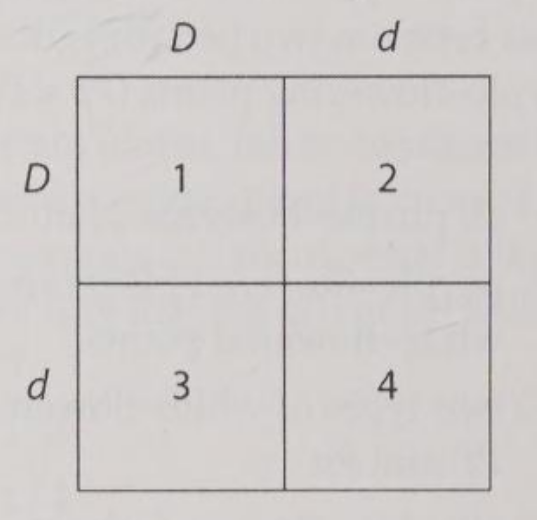
In a particular plant, leaf color is controlled by gene D. Plants with the dominant allele D have dark green leaves, and plants with the homozygous recessive dd genotype have light green leaves. A true-breeding dark-leaved plant is crossed with a light-leaved one, and the Fy offspring is allowed to self-pollinate. The predicted outcome of this cross is diagrammed in the Punnett square shown below, where 1, 2, 3, and 4 represent the genotypes corresponding to each box within the square.
Which of the boxes marked 1-4 correspond to plants with dark leaves?
A) 1 only
B) 1 and 2
C) 2 and 3
D) 4 only
E) 1, 2, and 3
E
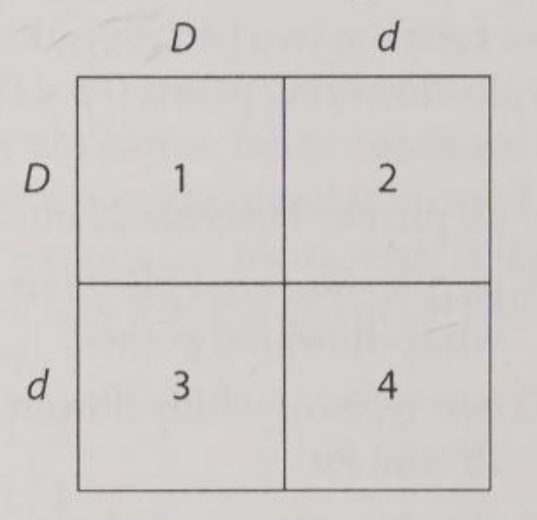
Which of the boxes correspond to plants with a heterozygous genotype?
A) 1
B) 1 and 2
C) 1, 2, and 3
D) 2 and 3
E) 2, 3, and 4
D
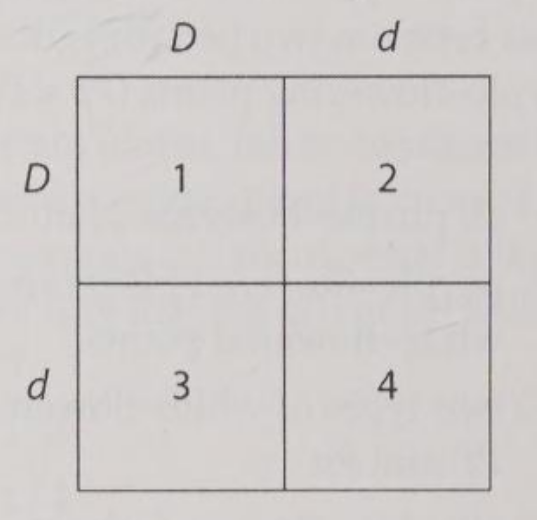
Which of the plants will be true-breeding?
A) 1 and 4
B) 2 and 3
C) 1 - 4
D) 1 only
E) none
A
P = purple, pp = white. The offspring of a cross between two heterozygous purple-flowering plants (Pp x Pp) results in
A) all purple-flowered plants.
B) purple-flowered plants and white-flowered plants.
C) two types of white-flowered plants: PP and Pp.
D) all white-flowered plants.
E) all pink-flowered plants.
B
Mendel accounted for the observation that traits which had disappeared in the F1 generation reappeared in the F2 generation by proposing that
A) new mutations were frequently generated in the F2 progeny, "reinventing" traits that had been lost in the F1.
B) the mechanism controlling the appearance of traits was different between the F1 and the F2 plants.
C) traits can be dominant or recessive, and the recessive traits were obscured by the dominant ones in the F1.
D) the traits were lost in the F1 due to blending of the parental traits.
E) members of the F1 generation had only one allele for each character, but members of the F2 had two alleles for each character
C
What are Punnett squares used for?
A) predicting the result of genetic crosses between organisms of known genotypes
B) determining the DNA sequence of a given gene
C) identifying the gene locus where allelic variations are possible
D) testing for the presence of the recessive allele
E) more than one of the above
A
Which of the following is false, regarding the law of segregation?
A) It states that each of two alleles for a given trait segregate into different gametes.
B) It can be explained by the segregation of homologous chromosomes during meiosis.
C) It can account for the 3:1 ratio seen in the F2 generation of Mendel's
crosses.
D) It can be used to predict the likelihood of transmission of certain genetic diseases within families.
E) It is a method that can be used to determine the number of chromosomes in a plant.
E
The fact that all seven of the pea plant traits studied by Mendel obeyed the principle of independent assortment means that
A) none of the traits obeyed the law of segregation.
B) the diploid number of chromosomes in the pea plants was 7.
C) all of the genes controlling the traits were located on the same chromosome.
D) all of the genes controlling the traits behaved as if they were on different chromosomes.
E) the formation of gametes in plants occurs by mitosis only.
D
Black fur in mice (B) is dominant to brown fur (b). Short tails (T) are dominant to long tails (t). What fraction of the progeny of the cross BbTt x BBtt will have black fur and long tails?
A) 1/16
B) 3/16
C) 3/8
D) 1/2
E) 9/16
D
In certain plants, tall is dominant to short. If a heterozygous plant is crossed with a homozygous tall plant, what is the probability that the offspring will be short?
A) 1/2
B) 1/4
C) 0
D) 1
E) 1/6
C
A couple has three children, all of whom have brown eyes and blond hair. Both parents are homozygous for brown eyes (BB), but one is a blond (rr) and the other is a redhead (Rr). What is the probability that their next child will be a brown-eyed redhead?
A) 1/16
B) 1/8
C) 1/4
D) 1/2
E) 1
D
Two true-breeding stocks of pea plants are crossed. One parent has red, axial flowers and the other has white, terminal flowers; all Fy individuals have red, axial flowers.
If 1,000 F2 offspring resulted from the cross, approximately how many of them would you expect to have red, terminal flowers? (Assume independent assortment.)
A) 65
B) 190
C) 250
D) 565
E) 750
B
In across AaBbCc x AaBbCc, what is the probability of producing the genotype AABBCC?
A) 1/4
B) 1/8
C) 1/16
D) 1/32
E) 1/64
E
Given the parents AABBCc x AabbCc, assume simple dominance and independent assortment. What proportion of the progeny will be expected to phenotypically resemble the first parent?
A) 1/4
B) 1/8
C) 3/4
D) 3/8
E) 1
C
A 1:2:1 phenotypic ratio in the F2 generation of a monohybrid cross is a sign of
A) complete dominance.
B) multiple alleles.
C) incomplete dominance.
D) polygenic inheritance.
E) pleiotropy.
C
A tall plant is crossed with a short plant, and the progeny are all intermediate in size between the two parental plants.
This could be an example of
A) incomplete dominance.
B) polygenic inheritance.
C) complete dominance.
D) A and B
E) B and C
D
A tall plant is crossed with a short plant, and the progeny are all intermediate in size between the two parental plants.
If the intermediate Fy progeny were allowed to self-pollinate, and the F progeny were also intermediate in size, but following a normal distribution, this would suggest
A) incomplete dominance.
B) polygenic inheritance.
C) complete dominance.
D) a strong environmental influence.
E) codominance
B
A tall plant is crossed with a short plant, and the progeny are all intermediate in size between the two parental plants.
If the intermediate F1 progeny were allowed to self-pollinate, and 25% of the F9 progeny were tall, 50% were intermediate in size, and 25% were short, this would suggest
A) incomplete dominance.
B) polygenic inheritance.
C) complete dominance.
D) pleiotropy.
E) multifactorial inheritance.
A
In snapdragons, heterozygotes have pink flowers, whereas homozygotes have red or white flowers. When plants with red flowers are crossed with plants with white flowers, what proportion of the offspring will have pink flowers?
A) 0%
B) 25%
C) 50%
D) 75%
E) 100%
E
Tallness (T) is dominant to dwarfness (t), while red (R) flower color is dominant to white (r), The heterozygous condition results in pink (Rr) flower color. A dwarf, red snapdragon is crossed with a plant homozygous for tallness and white flowers. What are the genotype and phenotype of the F1 individuals?
A) ttRr—dwarf and pink
B) ttrr—dwarf and white
C) TtRr—tall and red
D) TtRr—tall and pink
E) TTRR—tall and red
D
Skin color ina fish is inherited via a single gene with four different alleles. How many different types of gametes would be possible in this system?
A) 1
B) 2
C) 4
D) 8
E) 16
C
In cattle, roan coat color (mixed red and white hairs) occurs in the heterozygous (Rr) offspring of red (RR) and white (rr) homozygotes. Which of the following crosses would produce offspring in the ratio of 1 red:2 roan:1 white?
A) red x white
B) roan x roan
C) white x roan
D) red x roan
E) The answer cannot be determined from the information provided
B
Gene S controls the sharpness of spines in a type of cactus. Cactuses with the dominant allele, S, have sharp spines, whereas homozygous recessive ss cactuses have dull spines. At the same time, a second gene, N, determines whether cactuses have spines. Homozygous recessive nn cactuses have no spines at all.
The relationship between genes S and N is an example of
A) incomplete dominance.
B) epistasis.
C) complete dominance.
D) pleiotropy.
E) codominance.
B
A cross between a true-breeding sharp-spined cactus and a spineless cactus would produce
A) all sharp-spined progeny.
B) 50% sharp-spined, 50% dull-spined progeny.
C) 25% sharp-spined, 50% dull-spined, 25% spineless progeny
D) all spineless progeny
E) It is impossible to determine the phenotypes of the progeny.
A
If doubly heterozygous SsNn cactuses were allowed to self-pollinate, the F2 would segregate in which of the following ratios?
A) 3 sharp-spined : 1 spineless
B) 1 sharp-spined : 2 dull-spined : 1 spineless
C) 1 sharp spined : 1 dull-spined : 1 spineless
D) 1 sharp-spined : 1 dull-spined
E) 9 sharp-spined : 3 dull-spined : 4 spineless
E
Feather color in budgies is determined by two different genes Y and B. YYBB, YyBB, or YYBb is green; yyBB or yyBb is blue; YYbb or Yybb is yellow; and yybb is white.
A blue budgie is crossed with a white budgie. Which of the following results is not possible?
A) green offspring
B) yellow offspring
C) blue offspring
D) A and B
E) A, B, and C
D
Two blue budgies were crossed. Over the years, they produced 22 offspring, 5 of which were white. What are the most likely genotypes for the two blue budgies?
A) yyBB and yyBB
B) yyBB and yyBb
C) yyBb and yyBb
D) yyBB and yybb
E) yyBb and yybb
C
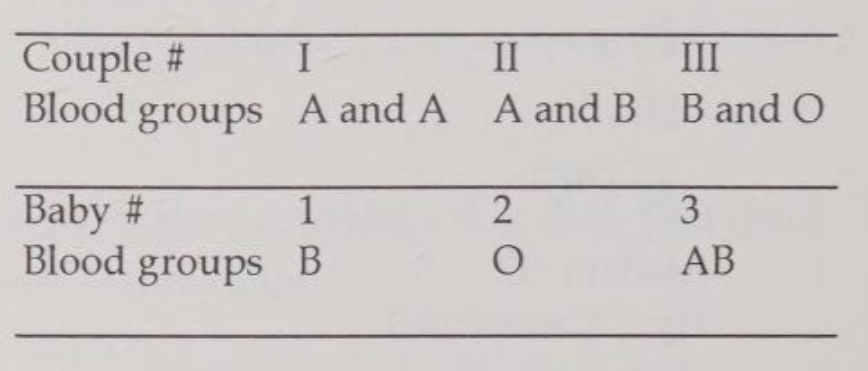
Three babies were mixed up in a hospital. After consideration of the data below, which of the following represent the correct baby and parent combinations?
A) 1-3, II-1, III-2
B) I-1, Il-3, IIl-2
C) I-2, II-3, III-1
D) I-2, II-1, III-3
E) 1-3, II-2, III-1
C
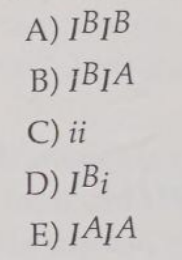
A woman who has blood type A, has a daughter who is type O positive and a son who is type B negative. Rh positive is a simple dominant trait over Rh negative.
Which of the following is a possible genotype for the son?
D
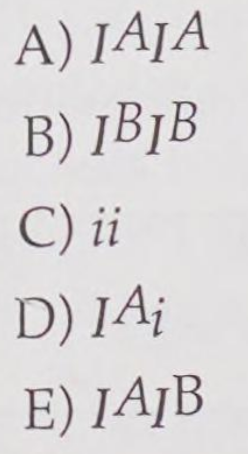
Which of the following is a possible genotype for the mother?
D
Which of the following is a possible phenotype for the father?
A) A
B) O
C) B
D) AB
E) impossible to detemrine
C
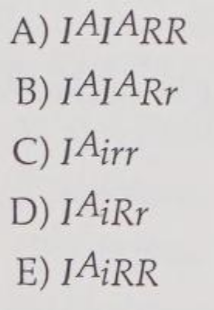
Which of the following is the probable genotype for the mother?
D
Which of the following is a possible phenotype of the father?
A) A negative
B) O negative
C) B positive
D) A positive
E) O positive
C
Which refers to the ability of a single gene to have multiple phenotypic effects?
A. incomplete dominance
B. multiple alleles
C. pleiotropy
D. epistasis
C
Which of the following describes the ABO blood group system?
A. incomplete dominance
B. multiple alleles
C. pleiotropy
D. epistasis
B
Which refers to the phenotype of the heterozygote differs from the phenotypes of both homozygotes?
A. incomplete dominance
B. multiple alleles
C. pleiotropy
D. epistasis
A
Cystic fibrosis affects the ulngs, the pancreas, the digestive system, and other organs, resulting in symptoms ranging from breathing diffuclties to recurrent infections. Which best describes cystic fibrosis?
A. incomplete dominance
B. multiple alleles
C. pleiotropy
D. epistasis
C
Which of the folliwing is ane xample of polygenic inheritance?
A) pink flowers in snapdragons
B) the ABO blood groups in humans
C) Huntington’s disease in huamns
D) white and purple flower colro in peas
E) skin pigmentation in huamns
E
Hydrangea plants of the same genotype are planted in a large flower garden. Some of the plants produce blue flowers and some others pink flowers. This can be best explained by
A) environmental factors such as soil pH
B) the allele for blue hydrangea being completely dominant
C) the alleles being codominant
D) the fact that a mutation has occurred
E) acknolwedging that multiple alleles are involved
A
A women and her spouse both show the normal phenotype for pigmentation, but both had one parent who was an albino. Albinism is an autosomal recessive trait.
What is the probability that their first child will be an albino?
A) 0
B) ¼
C) ½
D) ¾
E) 1
B
A women and her spouse both show the normal phenotype for pigmentation, but both had one parent who was an albino. Albinism is an autosomal recessive trait.
If their first two children have normal pigmentation, what is the probability that their third child will be an albino?
A) 0
B) ¼
C) ½
D) ¾
E) 1
B
A women and her spouse both show the normal phenotype for pigmentation, but both had one parent who was an albino. Albinism is an autosomal recessive trait.
Huntington's disease is caused by a dominant allele. If one of your parents has the disease, what is the probability that you, too, will have the disease?
A)1
B) 3/4
C) 2
D) 1/4
E) 0
C
A woman has six sons. The chance that her next child will be a daught is
A) 1
B) 0
C) 1/2
D) 1/6
E) 5/6
C
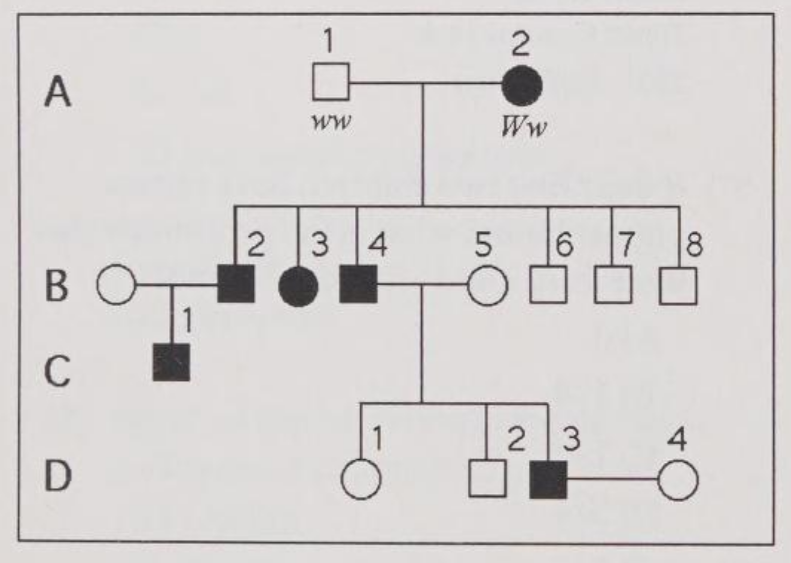
What is the genotype of individual B-5?
A) WW
B) Ww
C) ww
D) WW or ww
E) ww or Ww
C
What is the likelihood that the progeny of D-3 and D-4 will have wooly hair?
A) 0%
B) 25%
C) 50%
D) 75%
E) 100%
C
What is the probability that individual C-1 is Ww?
A) 3/4
B) 1/4
C) 2/4
D) 2/3
E) 1
E
People with sickle-cell trait
A) are heterozygous for the sickle cell allele
B) are usually healthy
C) have increased resistance to malaria
D) produce normal and abnormal hemoglobin
E) all of the above
E
When a disease is said to have a multifactorial basis, it means that
A) many factors, both genetic and environmental, contribute to the disease.
B) it is caused by a gene with a large number of alleles.
C) it affects a large number of people.
D) it has many different symptoms.
E) it tends to skip a generation.
A
Which of the following terms is least related to the others?
A) pedigree
B) karyotype
C) amniocentesis
D) chorionic villus sampling
E) epistasis
E
Subsitution of the ‘wrong’ amino acid in the hemoglobin protein results in this disorder.
A. Huntington's disease
B. Tay-Sachs disease
C. phenylketonuria
D. cystic fibrosis
E. sickle-cell disease
E
Individuals with this disorder are unable to metabolize certain lipids, affecting proper brain development. Affected individuals die in early childhood.
A. Huntington's disease
B. Tay-Sachs disease
C. phenylketonuria
D. cystic fibrosis
E. sickle-cell disease
B
This is caused by a dominant single gene defect and generally does not appear until the individual is 35-45 years of age.
A. Huntington's disease
B. Tay-Sachs disease
C. phenylketonuria
D. cystic fibrosis
E. sickle-cell disease
A
Effects of this recessive disorder can be completely overcome by regulating the diet of the affected individual.
A. Huntington's disease
B. Tay-Sachs disease
C. phenylketonuria
D. cystic fibrosis
E. sickle-cell disease
C
This results from a defect in membrane proteins that normally function in chloride ion transport.
A. Huntington's disease
B. Tay-Sachs disease
C. phenylketonuria
D. cystic fibrosis
E. sickle-cell disease
D
Which of the following techniques involves the preparation of a karyotype?
A) amniocentesis
B) chorionic villus sampling
C) fetoscopy
D) A and B only
E) A, B, and C
D
All the offspring of a cross between a black-eyed MendAlien and an orange-eyed MendAlien have black eyes. This means that the allele for black eyes is the allele for orange eyes.
A) codominant to
B) recessive to
C) more aggressive than
D) dominant to
E) better than
D
What is the expected phenotypic ratio of a cross between two orange-eyed MendAliens?
A) 3 black-eyed:1 orange-eyed
B) 0 black-eyed:1 orange-eyed
C) 1 black-eyed:3 orange-eyed
D) 1 black-eyed:0 orange-eyed
E) 1 black-eyed:1 orange-eyed
B
Andalusian chickens with the genotype C^BC^B are black, those with the genotype C^BC^W are gray. What is the relationship between the C^B and the C^W alleles?
A) C^B is dominant to C^W.
B) C^B is recessive to C^W.
C) C^W is dominant to C^B.
D) The relationship is one of incomplete dominance.
E) C^B and C^W are codominant.
A
Black eyes are dominant to orange eyes, and green skin is dominant to white skin. Sam, a MendAlien with black eyes and green skin, has a parent with orange eyes and white skin. Carole is MendAlien with orange eyes and white skin. If Sam and Carole were to mate, the predicted ratio of their offspring would be:
A) 1 black eyes, green skin : 1 black eyes, white skin : 1 orange eyes, green skin : 1 orange eyes, white skin
B) 3 black eyes, green skin : 3 black eyes, white skin : 9 orange eyes, green skin : 1 orange eyes, white skin
C) 1 black eyes, green skin : 3 black eyes, white skin : 3 orange eyes, green skin : 9 orange eyes, white skin
D) 9 black eyes, green skin : 3 black eyes, white skin : 3 orange eyes, green skin : 1 orange eyes, white skin
E) There is insufficient information to determine Sam's genotype.
A
All the offspring of a cross between a red-flowered plant and a white-flowered plant have pink flowers. This means that the allele for red flowers is to the allele for white flowers.
A) dominant
B) codominant
C) pleiotropic
D) incompletely dominant
E) recessive
D
In some plants, a true-breeding, red-flowered strain gives all pink flowers when crossed with a white-flowered strain: CRCR (red) x CWCW (white) > CRCW (pink). If flower position (axial or terminal) is inherited as it is in peas (see Table 14.1 in your text), what will be the ratios of genotypes and phenotypes of the F1 generation resulting from the following cross: axial-red (true-breeding) x terminal-white? What will be the ratios in the Fe generation?
Parental cross is AACRCR x aaCWCW. Genotype of F1 is AaCRCW, phenotype is all axial-pink. Genotypes of F2 are 4 AaCRCW: 2 AaCRCR : 2 AACRCW :2aaCRCW: 2 AaCWCW: 1 AACRCR: 1 aaCRCR: 1 AACWCW : 1 aaCWCW. Phenotypes of F2 are 6 axial-pink : 3 axial-red : 3 axial-white : 2 terminal-pink : 1 terminal-white : 1 terminal-red.

Flower position, stem length, and seed shape were three characters that Mendel studied. Each is controlled by an independently assorting gene and has dominant and recessive expression as follows:
If a plant that is heterozygous for all three characters is allowed to self-fertilize, what proportion of the offspring would you expect to be as follows? (Note: Use the rules of probability instead of a huge Punnett square.)
A) homozygous for the three dominant traits
B) homozygous for the three recessive traits
C) heterozygous for all three characters
D) homozygous for axial and tall, heterozygous for seed shape
A) 1/64
B) 1/64
C) 1/8
D) 1/32
A black guinea pig crossed with an albino guinea pig produces 12 black offspring. When the albino is crossed with a second black one, 7 blacks and 5 albinos are obtained. What is the best explanation for this genetic situation? Write genotypes for the parents, gametes, and offspring.
Albino (b) is a recessive trait; black (B) is dominant. First cross: parents BB x bb; gametes B and b; offspring all Bb (black coat). Second cross: parents bb x Bb; gametes 1/2 B and 1/2 b (heterozygous parent) and b; offspring 1/2 Bb and 1/2 bb.
In sesame plants, the one-pod condition (P) is dominant to the three-pod condition (p), and normal leaf (L) is dominant to wrinkled leaf (/). Pod type and leaf type are inherited independently. Determine the genotypes for the two parents for all possible matings producing the following offspring:
A) 318 one-pod, normal leaf: 98 one-pod, wrinkled leaf
B) 323 three-pod, normal leaf : 106 three-pod, wrinkled leaf
C) 401 one-pod, normal leaf
D) 150 one-pod, normal leaf : 147 one-pod, wrinkled leaf : 51 three-pod, normal leaf : 48 three-pod, wrinkled leaf
E) 223 one-pod, normal leaf : 72 one-pod, wrinkled leaf : 76 three-pod, normal leaf; 27 three-pod, wrinkled leaf
A) PPLI x PPLI, PpLl, or ppLl
B) ppLl x ppLl
C) PPLL x any of the 9 possible genotypes or PPIl x ppLL
D) PpLl x Ppll
E) PpLl x PpLl
A man with type A blood marries a woman with type B blood. Their child has type O blood. What are the genotypes of these individuals? What other genotypes, and in what frequencies, would you expect in offspring from this marriage?

Phenylketonuria (PKU) is an inherited disease caused by a recessive allele. If a woman and her husband, who are both carriers, have three children, what is the probability of each of the following?
A) All three children are of normal phenotype.
B) One or more of the three children have the disease.
C) All three children have the disease.
D) At least one child is phenotypically normal.
(Note: Remember that the probabilities of all possible outcomes always add up to 1.)
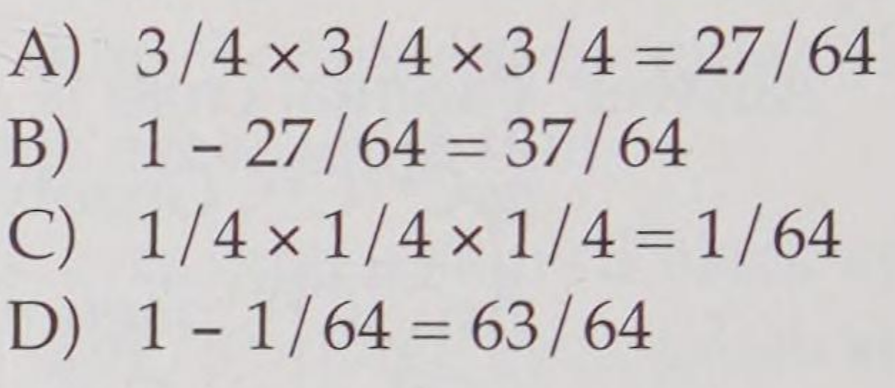
The genotype of F1 individuals in a tetrahybrid cross is AaBbCcDd. Assuming independent assortment of these four genes, what are the probabilities that F2 offspring will have the following genotypes?
A) aabbccdd
B) AaBbCcDd
C) AABBCCDD
D) AaBBccDd
E) AaBBCCdd

What is the probability that each of the following pairs of parents will produce the indicated offspring? (Assume independent assortment of all gene pairs.)
A) AABBCC x aabbcc —> AaBbCc
B) AABbCc x AaBbCc —> AAbbCC
C) AaBbCc x AaBbCc —> AaBbCc
D) aaBbCC x AABbcc —> AaBbCc
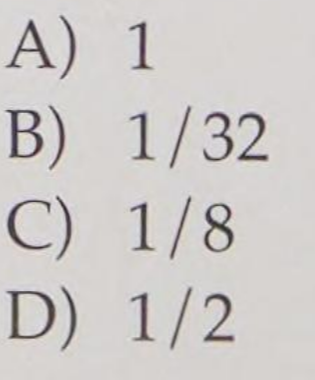
Karen and Steve each have a sibling with sickle-cell disease. Neither Karen nor Steve nor any of their parents have the disease, and none of them have been tested to reveal sickle-cell trait. Based on this incomplete information, calculate the probability that if this couple has a child, the child will have sickle-cell disease.
1/9
In 1981, a stray black cat with unusual rounded, curled-back ears was adopted by a family in California. Hundreds of descendants of the cat have since been born, and cat fanciers hope to develop the curl cat into a show breed. Suppose you owned the first curl cat and wanted to develop a true-breeding variety. How would you determine whether the curl allele is dominant or recessive? How would you obtain true-breeding curl cats? How could you be sure they are true-breeding?
Matings of the original mutant cat with true-breeding noncurl cats will produce both curl and noncurl F1 offspring if the curl allele is
dominant, but only noncurl offspring if the curl allele is recessive. You would obtain some true-breeding offspring homozygous for the curl allele from matings between the F1 cats
resulting from the original curl x noncurl crosses whether the curl trait is dominant or recessive. You know that cats are true-breeding when curl x curl matings produce only curl offspring. As it turns out, the allele that causes curled ears is dominant.